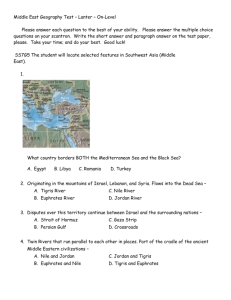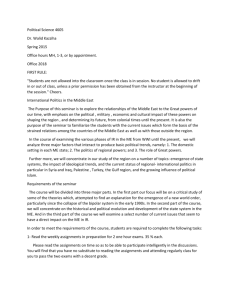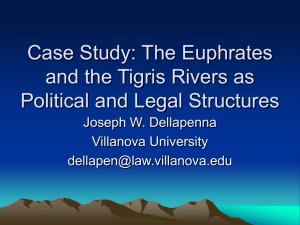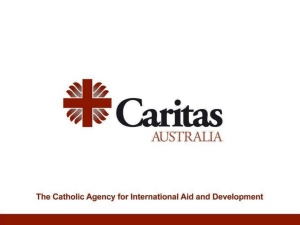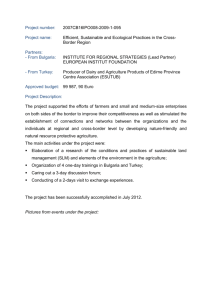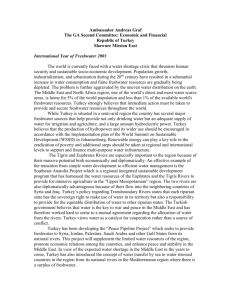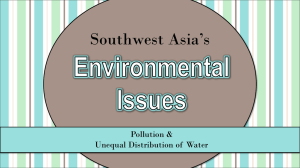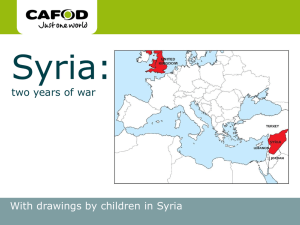The Tigris-Euphrates River Basin
advertisement
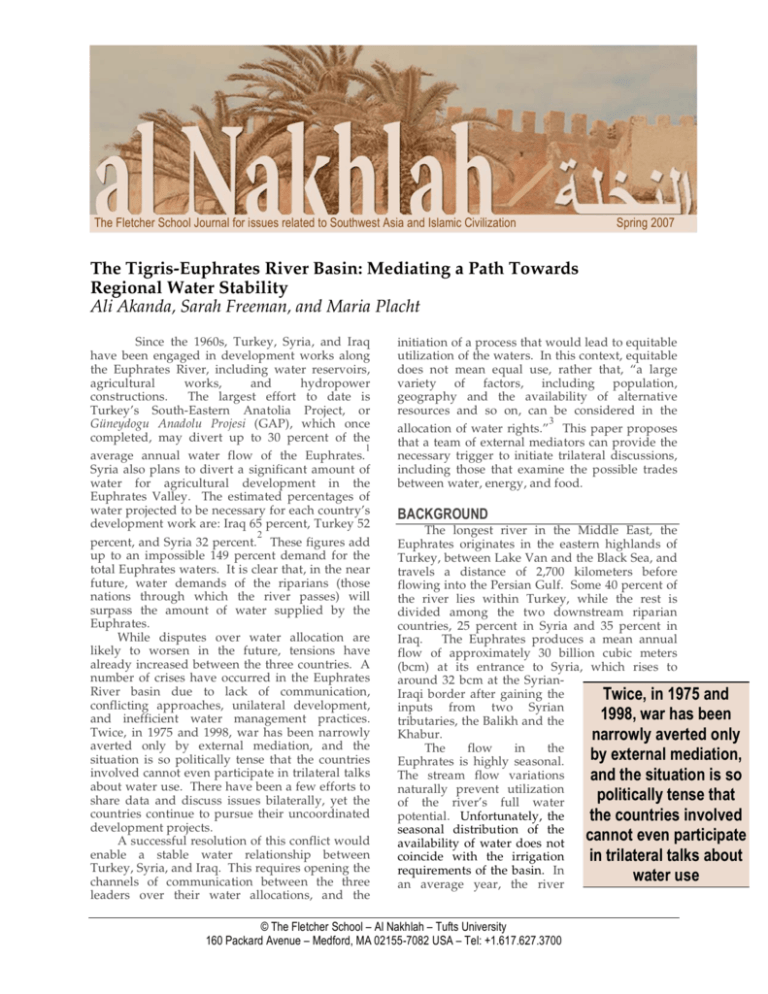
The Fletcher School Journal for issues related to Southwest Asia and Islamic Civilization Spring 2007 The Tigris-Euphrates River Basin: Mediating a Path Towards Regional Water Stability Ali Akanda, Sarah Freeman, and Maria Placht Since the 1960s, Turkey, Syria, and Iraq have been engaged in development works along the Euphrates River, including water reservoirs, agricultural works, and hydropower constructions. The largest effort to date is Turkey’s South-Eastern Anatolia Project, or Güneydogu Anadolu Projesi (GAP), which once completed, may divert up to 30 percent of the 1 average annual water flow of the Euphrates. Syria also plans to divert a significant amount of water for agricultural development in the Euphrates Valley. The estimated percentages of water projected to be necessary for each country’s development work are: Iraq 65 percent, Turkey 52 2 percent, and Syria 32 percent. These figures add up to an impossible 149 percent demand for the total Euphrates waters. It is clear that, in the near future, water demands of the riparians (those nations through which the river passes) will surpass the amount of water supplied by the Euphrates. While disputes over water allocation are likely to worsen in the future, tensions have already increased between the three countries. A number of crises have occurred in the Euphrates River basin due to lack of communication, conflicting approaches, unilateral development, and inefficient water management practices. Twice, in 1975 and 1998, war has been narrowly averted only by external mediation, and the situation is so politically tense that the countries involved cannot even participate in trilateral talks about water use. There have been a few efforts to share data and discuss issues bilaterally, yet the countries continue to pursue their uncoordinated development projects. A successful resolution of this conflict would enable a stable water relationship between Turkey, Syria, and Iraq. This requires opening the channels of communication between the three leaders over their water allocations, and the initiation of a process that would lead to equitable utilization of the waters. In this context, equitable does not mean equal use, rather that, “a large variety of factors, including population, geography and the availability of alternative resources and so on, can be considered in the 3 allocation of water rights.” This paper proposes that a team of external mediators can provide the necessary trigger to initiate trilateral discussions, including those that examine the possible trades between water, energy, and food. BACKGROUND The longest river in the Middle East, the Euphrates originates in the eastern highlands of Turkey, between Lake Van and the Black Sea, and travels a distance of 2,700 kilometers before flowing into the Persian Gulf. Some 40 percent of the river lies within Turkey, while the rest is divided among the two downstream riparian countries, 25 percent in Syria and 35 percent in Iraq. The Euphrates produces a mean annual flow of approximately 30 billion cubic meters (bcm) at its entrance to Syria, which rises to around 32 bcm at the SyrianIraqi border after gaining the Twice, in 1975 and inputs from two Syrian 1998, war has been tributaries, the Balikh and the Khabur. narrowly averted only The flow in the by external mediation, Euphrates is highly seasonal. The stream flow variations and the situation is so naturally prevent utilization politically tense that of the river’s full water potential. Unfortunately, the the countries involved seasonal distribution of the cannot even participate availability of water does not coincide with the irrigation in trilateral talks about requirements of the basin. In water use an average year, the river © The Fletcher School – Al Nakhlah – Tufts University 160 Packard Avenue – Medford, MA 02155-7082 USA – Tel: +1.617.627.3700 2 Al Nakhlah reaches its peak flow in April and May as the winter mountain precipitation melts. The typical low water season occurs from July to December, reaching its lowest point in August and September when water is most needed to irrigate 4 the region’s winter crops. The average monthly hydrograph of the Euphrates shows a variation between 33 percent and 275 percent of the annual average, evidence of the extent of its seasonal 5 fluctuations. Centuries of water use along these rivers have given rise to the Mesopotamian culture, cities, and peoples. To date, remains of ancient irrigation networks can be found in the desert plains of Syria and Iraq, many of which are still in use. For centuries, Iraqis and Syrians have used the Euphrates and the Tigris for drinking water as well as irrigation, and thus claim to have “acquired” rights to uninhibited use of the river, regardless of the changed hydro-political scenario upstream. BARRIERS TO COOPERATION The countries bordering the Tigris and Euphrates face technical, legal, and regional barriers to successful cooperation. In the TigrisEuphrates basin, data regarding stream flow, precipitation, evapotranspiration, water diversions, return flow, salinity, soil type, and other variables in relation to land resources, are very scarce, incomplete, and disputed at many locations. Moreover, crucial information As the largest water to water and land resources development relating resources of the region is not exchanged on a project in the region, regular basis among the GAP has caused riparians. A variety of considerable anxiety to different figures concerning availability of Turkey’s downstream irrigable land and soil neighbors, Syria and water requirements in each riparian country are Iraq, who fear that the available depending on project will lead to the origin of data and of the experts. reduced river flows and inclination In 1983, Turkey, Iraq, and leave little water for Syria established the Joint Technical Committee to use in their countries’ resolve such data agricultural and energy disputes. However, this group disintegrated after projects 1993 without having made much headway. The uncertain political setting, pursuit of shortterm national interests, lack of regularized institutions, and incomplete information contributed significantly to the termination of these meetings. The Arab countries have long accused Turkey of violating international water laws with regards to the Euphrates River. Iraq and Syria consider the river to be an international watercourse which should be treated as an integrated entity by all the riparian users. However, a significant legal barrier is that Ankara regards the Euphrates as a transboundary river, which is under Turkey's exclusive sovereignty until it flows across the border. According to Turkey, the Euphrates becomes an international river only after it joins the Tigris in lower Iraq to form the Shatt al-Arab, which then serves as the border between Iraq and Iran until it reaches the Persian Gulf. Furthermore, Turkey is the only country in the Euphrates basin to have voted against the United Nations Convention on the Law of Non-navigational Uses of International Watercourses. According to Turkey, if signed, the law would give "a veto right" to the lower riparians over Turkey’s development plans. Consequently, Turkey maintains that the Convention does not 6 apply to them and is thus not legally binding. Increasing regional tensions are an additional barrier to cooperation between the riparian countries. Since the 1960s, the three riparian countries of the Euphrates have had disagreements, of varying degrees of severity, over sharing the river. As the population of the region steadily increases, the quest for agricultural and food self-sufficiency has led to greater demands and in turn, supply-driven water projects have increased. Turkey constructed the first major dam of the basin, commissioning the Keban Dam in 1973, with Syria soon following suit with the Tabqa Dam in 1975. The filling of these dams caused a sharp decrease in downstream flow, causing Iraq and Syria to exchange mutually hostile accusations and come 7 dangerously close to a military confrontation. As regional water demand steadily increased, the riparian countries pursued their individual water infrastructure plans without any meaningful consultation with each other. In 1977, Turkey announced plans for the region’s biggest water development project ever, the GAP, which included a massive design of 22 dams and 19 hydropower projects. GAP is intended to provide irrigation, hydropower, and socio-economic development. The project area encompasses southeastern Turkey, around the headlands of the Euphrates and the Tigris rivers, and covers almost 10 percent of Turkey’s total population and surface area. The project is designed to harness the vast, untapped water potential of eastern Turkey. Its area includes about 42 percent of the © The Fletcher School – Al Nakhlah – Tufts University Spring 2007 total Tigris-Euphrates watershed within Turkey’s 8 boundary. As the largest water resources development project in the region, GAP has caused considerable anxiety to Turkey’s downstream neighbors, Syria and Iraq, who fear that the project will lead to reduced river flows and leave little water for use in their countries’ agricultural and energy projects. One of the early projects of GAP, the construction and filling of the Ataturk Dam, has been widely portrayed in the Arab media as a belligerent act. The hydro-political nature of GAP threatens regional stability, and will continue to do so if there is no agreement or understanding regarding its impacts. Meanwhile, Syria is carrying out its irrigation development projects to bring additional land under cultivation. These efforts began with the commissioning of the Tabqa Dam in 1975. Iraq fears that its hydraulic projects would be jeopardized by the upstream projects and 9 subsequent reductions in flow. Efforts to reconcile and establish an agreement for allocating the waters of the Euphrates were furthered in 1987 with an informal agreement between Turkey and Syria that guaranteed the latter a minimum flow of 500 m3/sec throughout the year. Syria has since accused Turkey of violating this agreement a number of times. The situation worsened when Turkey began the process of filling a new reservoir in the system, effectively shutting off the river flow for a month. Turkey returned to previous flow sharing agreements after the dam became operational, but the conflicts were never fully resolved as downstream demands had increased in the meantime. INTERESTS The major barriers to negotiations delineated above provide a solid background for understanding what may drive future decisions on the utilization of the waters of the TigrisEuphrates basin, but they do not tell the full story. The paramount national interests that give rise to each country’s position on the question of access to water must also be considered. The key interests identified are food, energy security, power, civil society stability, and economic development. The growing regional population has clear implications for the demand placed on food and energy resources in each country. If current population growth rates are sustained, the population of the three countries is predicted to 10 The longdouble in the next thirty-five years. standing emphasis on self-sufficiency in the interest of national security becomes less attainable in the face of rapidly expanding populations. Both the agricultural and energy sectors have felt the effects of the dramatic increase in requirements needed to fulfill each nation’s self-sufficiency quota. (i) Food security Syria, Iraq and Turkey have all shifted from being net exporters of grain to net importers, yet Syria and Iraq have even less ability to produce sufficient quantities of food staples. Despite its comparative food security, Turkey’s goal for GAP is to turn its southeastern region into a 11 For both of the lower riparians, breadbasket. Turkey’s water intensive development threatens their irrigation-based agricultural potential. Selfsufficiency in the agricultural sector has long been stressed in Syria and continues to be so, particularly with respect to staples such as wheat, 12 In Iraq, past policy has cotton, and olives. emphasized the reduction of foreign dependency on foodstuffs. Although emphasis on selfsufficiency has lessened due to present conflicts within the country, it has been stated as the longterm goal for the sector as reconstruction efforts 13 begin. (ii) Energy security Hydroelectric power has influenced the strategic plans for fulfilling the energy demands in both Syria and Turkey. Figure B1B1 depicts the importance of various fuel sources in each country. As can be inferred from this figure, the abundance of energy resources in Iraq makes the upstream control of flows less essential to internal energy supply. Turkey’s wish not to rely as heavily on external sources of energy is largely financially motivated. Turkey wishes to reduce its dependency on expensive imports by producing at least 40 percent of its required 14 energy from domestic hydroelectric sources. The GAP hydroelectric development was projected to save the country about 28 million 15 tons of oil imports annually. In 2001, Syria and Iraq were net exporters of fuel as opposed to Turkey, which, significantly, had to import approximately 63 percent of its fuel. Despite the fuel reserves that Syria possesses, hydropower is their predominant source of electric energy. This places Syria in a vulnerable position because Turkey has the potential to exert control over Syria’s primary electricity source, further 16 exacerbating an already contentious issue. (iii) Power As the Euphrates winds through the three major riparian nations, the power disparity © The Fletcher School – Al Nakhlah – Tufts University 3 4 Al Nakhlah between the countries is quite marked. Turkey’s position as the proverbial head of the group is bolstered by the respective flow contributions of each country and its position as the upper riparian. The power dynamics in play put Syria and Iraq in a position of inherent distrust of Turkish proposals. For example, in 1987, they rejected a three-stage plan proposed by Turkey for the “optimum, equitable, and reasonable utilization” of the waters of the Tigris and 17 Euphrates. Syria and Iraq demonstrated their distrust when they rejected the plan on the grounds that the conflict was solely about the Euphrates. Their fear behind this position was that Turkey would use Iraq and Syria’s access to the Tigris waters as reason for supplying them with less water from the Euphrates. Their position was again demonstrated in 1990 when Iraq and Syria put aside a long-standing tradition of disagreement in order to oppose Turkey’s cutoff of the flows to the 18 Euphrates during the filling of the Ataturk Dam. Arms investment in the region provides tangible evidence of the importance placed on overall power in the region. Syria, in particular, has invested in arms to increase its power parity 19 Mobilization of troops has with its neighbors. occurred both on the Iraqi-Syrian and the SyrianTurkish borders because of issues related to the Euphrates. Because there is such importance placed on the ability to impose force upon others, it is quiet feasible that these countries would consider withholding water as another military tool. This notion was even promoted by Turkey’s NATO allies following Iraq’s invasion of 20 Although regional power is a clear Kuwait. motivator, use of water as a means to impose force has not yet been realized. (iv) Internal Stability Plans of agricultural sector development often act to preserve and establish livelihoods that, in turn, promote internal stability. An example that demonstrates this link between livelihoods and internal stability is the situation of the Kurds in southeastern Turkey. Turkey has been continually preoccupied with Engaging in trilateral averting the potential negotiations is crucial establishment of a 21 The Kurdish state. if Turkey wants to GAP project is achieve its objectives designed to promote stability in the of joining the EU and southeastern region securing funding to of Turkey by finish GAP providing additional jobs to resident Kurds, and by diluting their population through enticing outsiders to settle in the area. Turkey hopes that this will not only increase stability in the area but will also stop the flow of immigrants from this region to the already 22 over-crowded cities. (v) Economic development The fact that the three countries’ water claims add up to an impossible 149 percent of the total water available in the basin demonstrates the importance of economic development to each nation. The use of water to accomplish their development objectives is most apparent in Turkey’s position. At the Ataturk Dam opening ceremonies in 1992, Suleyman Demirel, then president of Turkey, bluntly stated, “Neither Syria nor Iraq can lay claim to Turkey's rivers any more than Ankara could claim their oil… The water resources are Turkey's, the oil resources are theirs. We don't say we share their oil resources, and 23 they can't say they share our water resources.” Water-rich Turkey has used this justification in its planning of water intensive development projects. More recently, Turkey has even used water as a tool for improving foreign relations and generating income. Specific examples of this include the proposed Peace Pipeline and the Manavgat River Project, which focus on trading water with Mediterranean and Middle Eastern 24 neighbors, but have not yet been implemented. SITUATION RIPENESS A given conflict must reach a state of urgency, or ripeness, in order for resolution to be 25 In this formulation, a conflict is ripe feasible. when the involved parties feel that they will be worse off if no deal is struck. Sometimes, a third party has the ability to change the parties’ perceptions so that they view the situation as ripe. The scarcity of water in the region has brought attention to the possibility of water wars, but reality has shown that water is, in fact, too important to be left to the uncertainties of forceful 26 interventions. In some cases, water issues have, counter-intuitively, enabled cooperation in the 27 The vital nature of water, however, is region. often overshadowed by “symbolically charged” issues, such as defining the status of Jerusalem, obtaining favorable territorial boundaries, and 28 It is only when water gaining a lasting peace. availability is directly threatened that it becomes a 29 major concern for national security. © The Fletcher School – Al Nakhlah – Tufts University Spring 2007 Incentives Because water issues are often eclipsed by more politically charged concerns, it is essential to identify additional incentives to bring the Euphrates parties to the negotiation table. If sufficient incentives are placed on the table, negotiations may prove fruitful. Such a scenario will require both an appropriate third party mediator, as well as incentives with clear linkages to the previously defined national interests. There are two crucial incentives that, when combined, could entice Turkey to the negotiation table. First, Turkey’s struggle to become part of the European Union requires Ankara to improve its human rights record, which it could do by involving the Kurds in a cooperative water utilization effort. Second, Turkey requires external funding in order to finish GAP. Following the economic crisis in 2001 and a planned expansion of the project, Turkey can no longer internally fund GAP. However, potential external funding agencies, such as the EU and World Bank, require an agreement with downstream riparians before they will release funds. Engaging in trilateral negotiations is crucial if Turkey wants to achieve its objectives of joining the EU and securing funding to finish GAP. External incentives for both Syria and Iraq include development assistance by way of financial and technical support and increased water efficiency. When Syria demands more water from Turkey, Turkey counters this demand by describing Syria’s water practices as inefficient. Improved water practices would alleviate some of the pressure on both Syria and Iraq. Both countries have much to gain from technical assistance for their agricultural plans, as well as from funding for more innovative, advanced projects. Although increased efficiency of water usage would help to alleviate some of the pressure on limited water resources, modeling indicates that development demands would only be met if the current agricultural efficiency is increased by sixty percent. This is unrealistic because it would require a sixty percent reduction in water used to produce the same crop yield (see Figure A3). Historically, the three riparians have only negotiated when water levels have been so low as to seriously threaten their national security. For the sake of regional stability, proactive efforts must be undertaken now to prevent the next crisis. Only an external mediator has the ability to highlight the incentives and frame the issues in such a way that each country believes it has something to gain by coming to the table and something to lose by avoiding negotiations. TOWARDS REGIONAL WATER STABILITY This conflict requires an external intervention to bring the parties together because the countries have thus far failed to initiate successful, tripartite negotiations. On occasion, one country has initiated bilateral talks, but that is insufficient to begin discussions for a regional agreement. A mediator, on the other hand, can often work more directly to create conditions of ripeness and can “convince the parties that the path to achieving their preferred unilateral solutions is blocked, and, at the same time, offer them a credible, 30 mutually beneficial alternative solution.” Three potential mediators who have the necessary legitimacy and technical and financial resources are Saudi Arabia, Egypt, and the World Bank. Saudi Arabia Saudi Arabia has already successfully resolved a bilateral conflict involving the Euphrates. During 1974 and 1975, the region experienced a period of particularly dry weather, as well as the impounding of the Tabqa Reservoir in Syria, and the Keban Reservoir in Turkey. Iraq blamed Syria for reducing flows to unacceptable levels, and Syria in turn faulted Turkey. Iraq was not satisfied with Syria’s explanation and growing mutual threats brought Syria and Iraq to the brink 31 of war. The conflict was only diminished when Saudi Crown Prince Fahd brought the countries to the table and achieved a final resolution, which stipulated that Syria would release extra amounts of water to Iraq. In addition to being legitimate in the eyes of the riparian countries, Saudi Arabia has the financial resources to contribute to a basin fund that would finance irrigation reform and other methods to reduce unmet demand. Egypt As a mediator, Egypt brings to the table legitimacy and extensive experience gained in the process of working towards a basin agreement with the Nile Basin Initiative. Egypt has resolved crises in the region before. In 1998, Turkey charged Syria with supporting the PKK and harboring its leader, severely threatening relations between the two countries. Egyptian President Hosni Mubarak undertook a week of shuttle diplomacy between Ankara and Damascus, finally securing Syria’s pledge to stop supporting 32 While the subsequent security the PKK. agreement did not discuss the water issue, it demonstrated Egypt’s ability to negotiate successfully with Turkey and Syria. Egypt has also participated in seven years of discussions between the Nile riparian countries. Egypt would be in a position to apply the lessons from this © The Fletcher School – Al Nakhlah – Tufts University 5 6 Al Nakhlah experience to the Euphrates conflict, bringing insights and expertise to the table to generate options for resolving the dispute. World Bank The World Bank has a history of mediating water disputes, providing the necessary financial and technical resources and experience working in this region. In 1975, Turkey requested funding from the World Bank for a second dam downstream of the Keban. Despite the fact that the Bank and Turkey concluded that the existing downstream requirements could be satisfied, Syria and Iraq raised so many objections that the Bank decided to defer funding, leaving Turkey to 33 While Turkey was finance the project alone. able to finance this dam, it now desperately requires funding to finish the GAP project. The Bank has the potential to be a successful mediator because the three parties know that if they resolve the dispute, they will be able to access Bank funding for their development works. The Bank also has the technical expertise to ameliorate the inefficient, water-wasting practices of the riparians. Finally, the Bank itself has financial incentives to reach a resolution because it could then provide loans to these countries. Any combination of the three potential mediators would serve to open a channel of communication between the three conflicted parties. Tentative bilateral efforts are underway, such as the Joint Communiqué signed in 2001 between the GOLD (General Organization for Land Development – Syria) and the GAP-RDA 34 This (Regional Development Administration). agreement envisions supporting training, technology exchange, study missions, and joint projects, yet is limited because it only involves Turkey and Syria. Any bilateral efforts that exclude the third party, Iraq, are not sustainable and will not succeed in fostering a basin-wide effort. In fact, any data collected, decisions made, and conclusions drawn will collapse in the face of a third party who has not participated in the process. Such processes cannot be effective unless each party contributes equally. It is the role of a mediator to ensure equal participation and convince all parties that the path to achieving their preferred unilateral solutions is blocked. At the same time the mediator must facilitate the 35 formulation of a credible, alternative solution. Once the parties have come together under the auspices of a mediation team, they must break down barriers that have prevented negotiations from proceeding in the past, reconcile the three country approaches, and then examine trade agreements and imbalances. This will enable them to move forward to a process of sharing the benefits provided by the Euphrates as they search for an equitable solution to the Turkish officials claim utilization of the that it is more efficient Euphrates waters. The first barrier for Turkey to that must be dealt with concentrate on food is that of disputed data. A version of the production and to previous Joint exchange the surplus Technical Committee will need to define a for Iraqi oil and Syrian reasonable and gas appropriate amount of water that each country needs from both rivers. For example, many water experts have stated that the amount of irrigable land in both Syria and Iraq is far below the amount declared. Legal barriers are only likely to change if Turkey is accepted into the EU. Otherwise, Turkey will remain fundamentally opposed to changing the definition of the Euphrates. Regional tensions are likely to be lessened once a channel of communication has been opened between the three countries. Finally, the barrier of historical rights must be resolved by reaching a compromise regarding the principle of equitable utilization, which will demand an examination of the three country approaches. Each country has put forward an approach for how water should be shared in the region. Syria and Iraq’s approaches are vastly different from that of Turkey’s, so one aspect of the mediator’s role will be to reconcile these approaches. Syria and Iraq prefer a mathematical formula that will provide them with a specific allocation year round, while Turkey promotes a three stage plan designed to equitably distribute the water. Equitable distribution is characteristic of principals commonly promoted by upstream riparian countries. The framework Convention of the United States on Transboundary Waters (1997) is a good model for this conflict because it balances the rights of downstream and upstream parties. Disputed questions, which will need to be answered, include whether the Tigris and Euphrates form one single transboundary watercourse system, whether the flow should be steady or adjusted for seasonal variability, and whether the principle of territorial integrity or equitable utilization should be followed. Part of the discussion process would benefit from an examination of the trade imbalance and the trade agreements that will promote the most effective use of the Euphrates waters. The 1987 Trade Agreement between Turkey and Syria stipulated that 500m3/sec enter Syria, demonstrating that water has been tied to trade © The Fletcher School – Al Nakhlah – Tufts University Spring 2007 issues in the past. One possible solution is that the countries will reconsider domestic water allocation and shift their water emphasis from irrigation to domestic and industrial use and imported foodstuffs. As Turkey transforms the GAP region into a food export zone, Iraq will be a likely market for food imports, especially as it was already importing close to 80 percent of its food prior to the Gulf 36 Iraq is only likely to increase its War. dependence on imports as increasing soil salinization and poor water quality make food production even more difficult and costly. However, reconciling the trade imbalance will not be easy. Turkish officials claim that it is more efficient for Turkey to concentrate on food production and to exchange the surplus for Iraqi oil and Syrian gas. Syria admits that its land is not as productive as Turkey's, citing this as the reason why they require more water on a regular basis. Syria favors the introduction of watersaving technology but cautions that it will take time to switch to new technology as it involves a change of cultural patterns. Syria points to the International Labor Conference’s rule that comparative economic output is not to be a criterion for allocating international waters, and stresses that food security is vital to its national interests. Agriculture employs 25 percent of Syria’s labor force and contributes nearly 30 Opening channels of communication between the three countries may help avert the next water crisis and enhance regional security 37 If Syria were deprived of percent of its GDP. sufficient water to irrigate its land, migration out of the rural areas to cities would occur, causing social dislocation and unemployment. Hydropolitical linkages are increasingly being made making it plausible that mediators that mediators may even encourage connecting the conflict to political disputes. These “multiresource linkages may offer more opportunities for generating creative solutions, allowing for greater economic efficiency through a "basket" of 38 Some benefits included in previous benefits.” water negotiations include financial resources, energy resources, political linkages, transportation infrastructure, and data. The feasibility of such linkages will depend on the mediator’s ability to assist in the process of breaking down barriers and exploring trade options. If that has been enabled by the mediator, the parties will then be prepared to discuss a comprehensive strategy for water allocation. CONCLUSION Allocation of the waters in the TigrisEuphrates basin has been a long-standing cause of disputes in the region. Difficulties involving the hydrology of the basin and barriers to negotiation are confounding factors that plague possible resolution of the conflicting interests. A comparison of the national interests of Turkey, Syria, and Iraq help to identify possible incentives and methodologies that can lead to a productive conversation about benefit sharing and equitable utilization of the waters. Finally, Egypt, Saudi Arabia, and the World Bank are three possible mediators that have the capacity to instigate trilateral negotiations. Trilateral negotiations would provide an opportunity for the interests and concerns of each country to be considered, and would allow the triangle of needs - food, energy, and trade security of each country - to be discussed in a fair and equitable manner. Opening channels of communication between the three countries may help avert the next water crisis and enhance regional security. Many components of this conflict deserve further exploration. For example, links and tradeoffs between the elements in the triangle of needs, particularly the roles of virtual water trade and energy-water trade, need more clarification. The socio-economic implications of these trade options will be far-reaching and will have the potential to motivate stakeholders to negotiate a settlement that would greatly strengthen their economies. How Iraq’s present conflict might affect a unified Iraqi voice at the negotiation table, especially with increasingly fractured regional politics, remains to be seen. Additional research is also needed to further explore the physical constraints inherent throughout the system. In the future, basin models should incorporate the effects of groundwater interaction, climate change, and water quality. The ultimate goal for the region is an international basin organization that would enable cooperation on a continuous basis and would emphasize sustainable solutions to water sharing. As described in the Dublin Statement on Sustainable Water Development, “The essential function of existing international basin organizations is one of reconciling and harmonizing the interests of riparian countries, monitoring water quantity and quality, development of concerted action programs, exchange of information, and enforcing 39 However, a basin organization is agreements.” not the present objective, as Iraq, Syria, and Turkey still have historic hostilities to overcome, trust to develop, and many technical, informational, and financial challenges ahead. Opening trilateral channels of communication and © The Fletcher School – Al Nakhlah – Tufts University 7 8 Al Nakhlah creating an accepted space for negotiation would be a significant step in the pursuit of regional stability. Figure A1 WEAP schematic for the Tigris-Euphrates River Basin. APPENDIX A: WEAP MODEL This study used the Water Evaluation and Planning System (WEAP) model to simulate the possible water demand scenarios in the Euphrates river basin. A schematic model was developed comprising of units representing the river, water reservoirs in the three riparian countries, agricultural demands and water supply requirements of cities that are dependent on the Euphrates (Figure A1). An estimation of the agricultural requirements used data from the areas presently under irrigation in the three countries and from per hectare irrigation water demands cited in research journals for this region. Calculations of future demands considered growth projections of the GAP and the region’s agricultural and water resources publications. Two major cities (Aleppo in Syria and Ramadi in Iraq) that depend directly on the Euphrates flow were factors in the model calculations. Different non-governmental agency documents provided data on the cities’ present and future population demands and water use requirements. The simulation considered six major reservoirs that had the maximum storage area. Three of the major reservoirs identified are in Turkey, two in Syria, and one in Iraq. Figure A2 WEAP demand forecasting. Figure A2 compares the demands forecasted by WEAP for a Reference scenario (a steady demand) and the GAP at full development scenario. The average monthly water demand of the full development scenario is significantly higher than the existing demand structure, with the unmet demands peaking to about 50% of the present demands during the low flow months of August and September. This estimate is similar to other future unmet demand projections of the three riparians. © The Fletcher School – Al Nakhlah – Tufts University Spring 2007 Figure A3 Excess demand for efficiency scenarios of 20, 40, and 60 percent when the GAP project is operating at full capacity. Note that demands are only met when irrigation efficiency is increased to an unrealistic 60%. Figure B1 Energy production in Turkey, Syria, and Iraq. Data Source: World Resources Institute Energy Production: Syria (1999) Solid Fuels Liquid Fuels Gaseous Fuels Hydroelectric © The Fletcher School – Al Nakhlah – Tufts University 9 10 Al Nakhlah Ali Shafqat Akanda is a civil engineer by training and has an MA from the University of Oklahoma. After working in the engineering software industry for several years, he returned to graduate school to pursue a doctorate. He is a Dean’s Fellow in Civil & Environmental Engineering at Tufts. Sarah Freeman, Tufts School of Engineering 2007, is currently a member of the WSSS (Water: Systems, Science, and Society) Program. Her thesis is on the use of indicators to assess possible water resources development pathways and vulnerability to conflict in Africa. Her research interests include appropriate technology and the interaction between policy and water resources planning. Maria Placht is a first-year student at The Fletcher School studying environmental policy and negotiation, with a specific focus on transboundary water conflict prevention and resolution. The views and opinions expressed in articles are strictly the author’s own, and do not necessarily represent those of Al Nakhlah, its Advisory and Editorial Boards, or the Program for Southwest Asia and Islamic Civilization (SWAIC) at The Fletcher School. © The Fletcher School – Al Nakhlah – Tufts University Spring 2007 WORK CITED 1 Ali Ishan Bagis, GAP, Southeastern Anatolia Project: The Cradle of Civilization Regenerated, (Istanbul: Interbank, 1989). 2 Aysegul Kibaroglu, and Ünver I. H. Olcay, “An Institutional Framework for Facilitating Cooperation in the Tigris-Euphrates River Basin,” International Negotiation 5 (2) (2000) Special Issue “Negotiating in International Watercourses: Water Diplomacy, Conflict and Cooperation”: 311-330. 3 Arnon Medzini and Aaron Wolf, “The Euphrates River Watershed: Integration, Coordination, or Separation?” in M. Finger, L.Tamiotti and J. Allouche eds.. The Multi-Governance of Water: Four Case Studies (Albany: SUNY Press, 2005). 4 Ibid. 5 Bagis. 6 George E. Gruen, “Turkish Waters: Source of Regional Conflict of Catalyst for Peace?” Water, Air, and Soil Pollution 123 (2000): 565-579. 7 Daniel Hillel, Rivers of Eden: The Struggle for Water and the Quest for Peace in the Middle East (New York: Oxford University Press, 1994); and Medzini and Wolf. 8 Dogan Altinbilek, “Development and Management of the Euphrates–Tigris Basin,” Water Resources Development 20 (1) (2004): 15-33. 9 Natasha Beschorner, “Water and Instability in the Middle East,” Adelphi Paper 273, International Institute for Strategic Studies (Winter 1992/93). 10 Michael T. Klare, Resource Wars, (New York: Henry Holt and Company, 2002). 11 Hillel. 12 The Federation of International Trade Association Country Profile, “Turkey,” <http://www.fita.org/countries/turkey.html > (accessed December 4, 2006). 13 United Nations and World Bank, Joint Iraq Needs Assessment Working Paper. October 2003, <http://siteresources.worldbank.org/IRFFI/Resources/Joint+Needs+Assessment.pdf> (accessed December 7, 2006). 14 Ilter Turan, “Water and Turkish Foreign Policy” in Martin G. Lenore and Dimitris Keridis, eds., The Future of Turkish Foreign Policy (Cambridge, MA: MIT Press, 2004), 191-208. 15 Bagis. 16 Hillel. 17 Martin and Keridis. 18 Klare. 19 Hillel; and Klare. 20 Gruen. 21 “Turkey and the European Union: The ever lengthening road,” The Economist, December 9, 2006. 22 Martin and Keridis; and Hillel. 23 Christopher Reed, “Paradise Lost: What should--or can--be done about "the environmental crime of the century"?” Harvard Magazine, January-February 2005, <http://www.harvardmagazine.com/on-line/010538.html> (accessed December 1, 2006). 24 Martin and Keridis. 25 Richard N. Haass, Conflicts Unending (New Haven, CT: Yale University Press, 1990); and Stephen J. Stedman, Peacemaking in Civil War: International Mediation in Zimbabwe, 1974-1980 (Boulder, CO: 1991); and I. W. Zartman, Ripe for Resolution: Conflict and Intervention in Africa (New York: Oxford University Press, 1989). 26 John Anthony Allan, “Hydro-Peace in the Middle East: Why no Water Wars? A Case Study of the Jordan River Basin.” SAIS Review XXII (2) (2002). 27 E. Feitelson and M. Haddad, (eds.) Management of Shared Groundwater: The Israeli - Palestinian Case with an International Perspective (IDRC/Kluwer Academic, 2001); and J. Waterburym, Hydropolitics of the Nile Valley (New York: Syracuse University Press, 1979). 28 Allan. 29 Klare. 30 Haass. 31 Aysegül Kibaroglu, “Settling the Dispute Over the Water Resources in the Tigris-Euphrates River Basin” proceedings From Conflict to Co-operation in International Water Resources Management: Challenges and © The Fletcher School – Al Nakhlah – Tufts University 11 12 Al Nakhlah Opportunities (Delft, The Netherlands: UNESCO-IHE Institute for Water Education International Conference, Nov. 2002). 32 Hilal Elver, “Emerging Water conflict in the Middle East?: The Case of the Euphrates and the Tigris Rivers Basin” paper and presentation for Water: Dispute Prevention and Development (Washington D.C.: American University Center for the Global South, October 12 – 13, 1998). 33 Gruen, 565-579. 34 Kibaroglu, “Settling the Dispute Over the Water Resources in the Tigris-Euphrates River Basin.” 35 Marieke Kleiboer, “Ripeness of Conflict: A Fruitful Notion?” Journal of Peace Research 3 (1) (Feb, 1994): 109116. 36 Beschorner. 37 Avraham Sela, ed., "Water Politics," in Political Encyclopedia of the Middle East (New York: Continuum, 1999). 38 Medzini and Wolf. 39 United Nations Environmental Program, Final Report of the International Conference on Water and the Environment, Dublin (Nairobi: UNEP, 1992). 40 Peter Beaumont, “Agricultural and Environmental Changes in the Upper Euphrates Catchment of Turkey and Syria and their political and economic implications,” Applied Geography 16 (2) (1996): 137-157; and T. Y. Oweis and A.Y. Hachum,“Improving water productivity in the dry areas of West Asia and North Africa.” in J.W. Kijne, R. Barker, R, D. Molden. eds., Water productivity in agriculture: Limits and opportunities for improvement (Wallingford, UK: CAB International Water Management Institute, 2003). 41 Altinbilek; and Kibaroglu and Ünver. 42 Altinbilek. 43 Kibaroglu and Ünver. © The Fletcher School – Al Nakhlah – Tufts University
